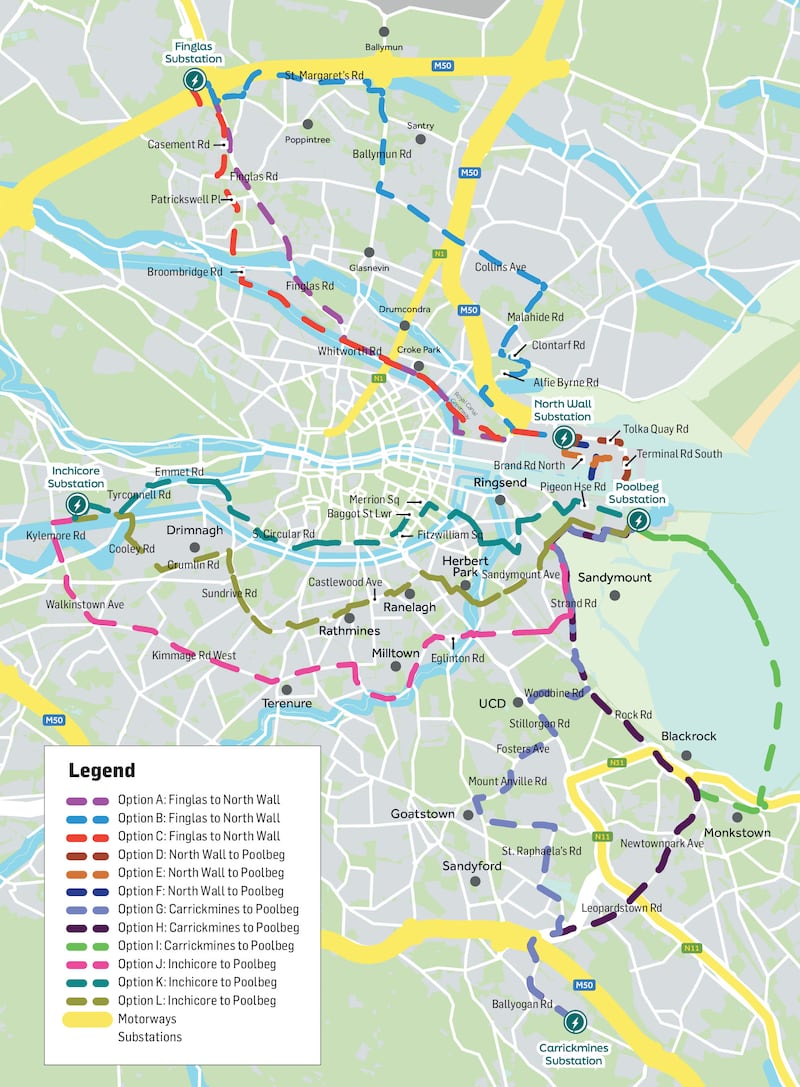Route options for the installation of 50km of underground electricity cables across Dublin, likely to cause traffic disruption for up to five years, will be published on Tuesday by EirGrid.
The operator is to embark on a major upgrade of capital’s electricity grid, replacing underground cabling – some of which is up to 50 years old – on routes linking substations at Carrickmines and Poolbeg; North Wall and Poolbeg; Finglas and North Wall; with two routes required to link Inchicore and Poolbeg.
The Powering Up Dublin project will require a “considerable amount of roadworks”, EirGrid has said, and will have the widest impact on the south of the city with disruption in Sandymount almost inevitable.
EirGrid has identified 12 route options for the cables from which it will choose the five final routes where roads will need to be opened up for the installation of the power lines. The work is due to start next year and be completed by 2029. Three options have been put forward for each area and will be available for public consultation for eight weeks from Tuesday.
Look inside: Elegant Victorian on Burlington Road with spacious back garden and wine cellar for €2.75m
Charming Ranelagh mews with grape vine in the garden for €1.05m
Light-filled two-bed in Phibsborough makes for great city home for €425,000
Two fine period houses on sought-after Palmerston Road for €2.75m and €2.85m

Carrickmines
For the Carrickmines route, two of the three options travel from Poolbeg along Strand Road in Sandymount, which has been at the centre of a long-running dispute over Dublin City Council’s plans to install a cycle path that would require a one-way traffic system on the road. Strand Road has also, since last October, been partially restricted to one lane of traffic for a water-mains replacement programme due to continue until the middle of this year. Sandymount residents have already complained to the council and the Office of Public Works that the road is subject to a “never-ending cycle of piecemeal development”.
The third potential cable route would go from Poolbeg into the sea, making landfall at Monkstown before continuing to Carrickmines.
Inchicore
Of the three Inchicore to Poolbeg options, two will be selected as separate routes are required for each of the two cables needed. One of these three routes also uses Strand Road, before heading west on Ailesbury Road and Eglinton Road towards Milltown and Terenure, then north through Kimmage and Walkinstown to reach Inchicore.
A second route runs along Sandymount Avenue and Appian Way to reach Ranelagh then continues west through Rathmines, Harold’s Cross and Drimnagh to Inchicore.
The final of these three routes goes though the south inner city using Ballsbridge to reach the south Georgian core, passing Merrion Square and Fitzwilliam Square, then using the South Circular Road to reach Inchicore.
[ Eirgrid could spend €270m on offshore consultantsOpens in new window ]
Finglas
On the north side of the city the Finglas to North Wall options include a route which heads south to Broombridge in Cabra before going off-road along the Royal Canal, which is designated for a cycling greenway, to head towards the north docks. Another route uses the Finglas dual carriageway to reach the canal at Whitworth Road. A third route goes through Ballymun, continuing east along Collins Avenue to the Malahide Road and Clontarf, before heading south to North Wall.
North Wall
The shortest cabling section is the North Wall and Poolbeg connection. While three routes have been put forward here, they are all within Dublin Port Company’s land and are unlikely to cause disruption for residents.
The level of traffic disruption and disturbance for residents and businesses in each area will depend on the routes chosen, EirGrid said. The cables will be installed in trenches up to 1.1m wide and “the width of the roads selected will determine the need for road closure,” a spokesman said. “Depending on location and width, we’ll be looking to lay between nine to 30 metres of cables a day. We’re trying to get a good gauge from communities of what actions may be most disruptive so we can mitigate this where possible.”
The company was also endeavouring to identify opportunities to lay lines where other works by public utilities were ongoing or planned “to help minimise disruption” it said.
The consultation process will include a series of public information events taking place around the city, along with online webinars and drop-in clinics in different areas. Details are available at Consult.EirGrid.ie.












